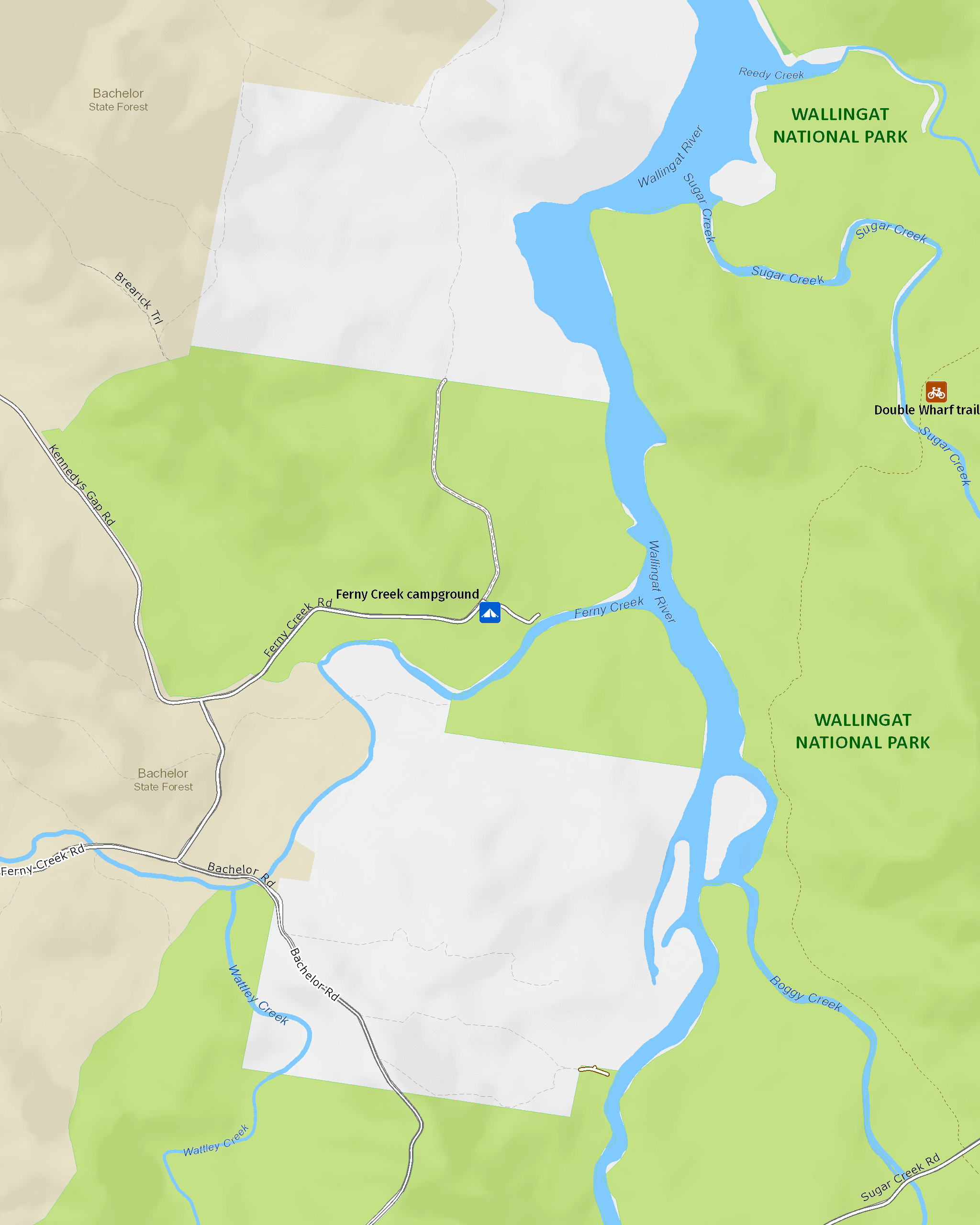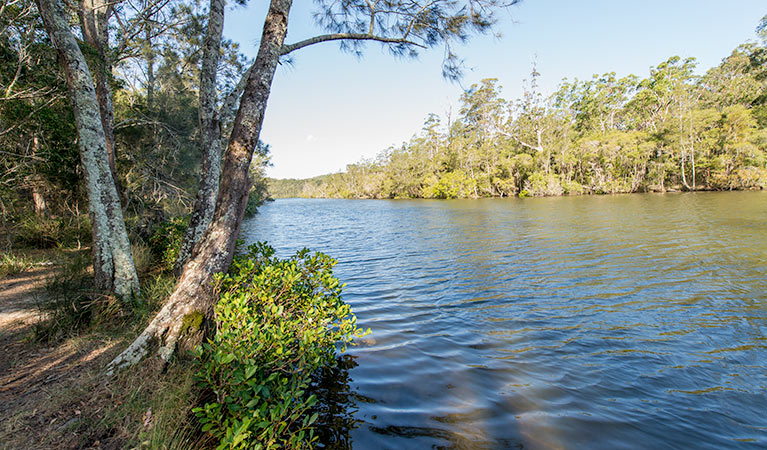Overview
Ferny Creek campground is an even more private alternative to Wallingat River campground in Wallingat National Park, with opportunities for fishing, kayaking, birdwatching and picnicking.
| Camping type | Tent, Camper trailer site, Caravan site, Camping beside my vehicle |
|---|---|
| Facilities | Unpowered sites, unmarked sites |
| What to bring | Drinking water, cooking water, fuel stove |
| Price | |
| Bookings | Book up to 12 people or 2 sites online. |
| Group bookings | School groups and Park Eco Pass holders can make a group booking enquiry. |
| Please note |
|
Many visitors looking to camp overnight in Wallingat National Park will opt for Wallingat River campground, which offers basic facilities in a stunning setting of eucalyptus trees. A more adventurous and private option, though, can be found at Ferny Creek campground, on the western side of Wallingat River.
You need a 4WD to access this remote spot, or alternatively, you can paddle there from the boat ramp at Cockatoo picnic area. Kayaks can be launched into the creek, and it’s a great spot for birdwatching as you might see sea eagles and osprey circling overhead. Wallabies, kangaroos and echidnas wander through the campground. In the warmer months, you can cool down with a refreshing swim, then cosy up around the campfire.
The riverside setting along Ferny Creek is great for fishing, with scenic views across the waterways, giving you plenty of choice as you explore the deeper regions of the national park.
Map

Map legend

Local alerts
For the latest updates on fires, closures and other alerts in this area, see https://www.nationalparks.nsw.gov.au/camping-and-accommodation/campgrounds/ferny-creek-campground/local-alerts
Bookings
- National Parks Contact Centre
- 7am to 7pm daily
- 1300 072 757 (13000 PARKS) for the cost of a local call within Australia excluding mobiles
- parks.info@environment.nsw.gov.au
Operated by
- Booti Booti Office
- Monday to Friday, 8.30am to 4.30pm. Closed public holidays.
- 02 6591 0300
- npws.manninggreatlakes@environment.nsw.gov.au
- The Ruins campground, Booti Booti National Park, 4374 The Lakes Way, Booti Booti 2428
Park info
- in Wallingat National Park in the North Coast region
Wallingat National Park is always open but may have to close at times due to extreme weather or fire danger.
Visitor info
All the practical information you need to know about Ferny Creek campground.
Getting there and parking
Ferny Creek campground is in Wallingat National Park. To get there:
- Turn off Pacific Highway at Kennedy's Gap Road
- Follow Kennedy's Gap Road to Ferny Creek Road
- Turn left along Ferny Creek Road and follow to the campground
Road quality
- Unsealed roads
Vehicle access
- All roads require 4WD vehicle
Weather restrictions
- All weather
Parking
Parking is available at Ferny Creek campground.
Best times to visit
There are lots of great things waiting for you in Wallingat National Park. Here are some of the highlights.
Autumn
With temperatures slightly cooler, explore the network of gravel roads by foot or on a mountain bike.
Spring
With the wildflowers - including the purple blooms of the velvet mint-bush - coming out, this is a great time for birdwatching.
Summer
The weather is warm and sunny, so now's the time to pitch a tent and stay for a few days. Make the most of the boat ramp at Cockatoo picnic area Head to Sugar Creek picnic area and, after lunch, take a walk through the cool forest. .
Winter
Visitor numbers are down, so take the car along the park's unsealed roads and discover the forest, rivers and lake.
Weather, temperature and rainfall
Summer temperature
Average
20°C and 29°C
Highest recorded
45.2°C
Winter temperature
Average
7°C and 21°C
Lowest recorded
-5°C
Rainfall
Wettest month
March
Driest month
Sept
The area’s highest recorded rainfall in one day
280.2mm
Facilities
- Water is not available at this campground.
- You're encouraged to bring gas or fuel stoves, especially in summer during the fire season.
Types of sites
- Unpowered sites
- Unmarked sites
Maps and downloads
Permitted
Fishing
A current NSW recreational fishing licence is required when fishing in all waters.
Prohibited
Pets
Pets and domestic animals (other than certified assistance animals) are not permitted. Find out which regional parks allow dog walking and see the pets in parks policy for more information.
Smoking
NSW national parks are no smoking areas.
Learn more
Ferny Creek campground is in Wallingat National Park. Here are just some of the reasons why this park is special:
Ancient footprints

The 6,557ha of Wallingat National Park is part of the identity and spirituality, as well as a resource, for people of the Worimi nation. The Worimi People lived a traditional hunter-gatherer lifestyle and used the leaves of the cabbage palm for weaving baskets and its fibrous bark for making fishing line. They used many of the area's natural resources, including the freshwater lakes, stone outcrops, and the ocean. A central campsite was known to exist in the area now known as Coomba Park, although there are few other Aboriginal sites recorded within the park include the Bungwahl area.
Fun times

Whether you're after a relaxing time or something more adventurous, Wallingat is just the spot. Take to the gravel roads either on foot, in a car or on a bike – to explore the forests. You can swim, fish and paddle on Wallingat River. Pitch a tent in the campground and get away from it all for a few days in this naturally beautiful setting. Surrounding some of the picnic areas and campsites, you’ll find magnificent stands of trees. In the southeast corner of Wallingat, there are tall, straight flooded gums, as well as stands of cabbage palms. Find both during a walk from Sugar Creek picnic area. Some rare plants such as the liana woody climber, a climbing species that bears white flowers from August to May, can also be found here.
- Double Wharf trail Experience the scenic waterways and mountainous forests of Wallingat National Park along Double Wharf trail – perfect for walking or mountain bike riding.
- Wallingat Forest drive The 25km loop of Wallingat Forest drive, near Forster, is on unsealed roads that meander through forests, and excellent for cars, 4WDs, bicycles, walking and horse riding.
- Whoota Whoota lookout From Whoota Whoota lookout, easily accessible by car, you can see for miles. Take in scenic views of Wallingat’s eucalypt forests, Wallis Lake and 100km of coastline.
Life among the trees

More than 200 species of birds make Wallingat National Park a home. Walking through forest as well as stands of straight flooded gums, and cabbage palms, you'll hear birds singing. Noisy friarbirds, for instance, have a distinctive 'ya-kob' call, while a 'woop, woop, woop' sound signals the presence of the wonga pigeon. You might see blue wrens flitting through the trees, as well as king parrots and glossy black cockatoos. Wallingat is also a popular spot for the satin bowerbird – the males are black and shiny, the females are a plainer brown. They both, however, have startling lilac eyes.
- Double Wharf trail Experience the scenic waterways and mountainous forests of Wallingat National Park along Double Wharf trail – perfect for walking or mountain bike riding.
- Sugar Creek picnic area Sugar Creek picnic area is a family-friendly relaxation spot with easy walking trails through forested landscape, a leisurely drive from Forster and Pacific Palms.
Bookings
- National Parks Contact Centre
- 7am to 7pm daily
- 1300 072 757 (13000 PARKS) for the cost of a local call within Australia excluding mobiles
- parks.info@environment.nsw.gov.au
Operated by
- Booti Booti Office
- Monday to Friday, 8.30am to 4.30pm. Closed public holidays.
- 02 6591 0300
- npws.manninggreatlakes@environment.nsw.gov.au
- The Ruins campground, Booti Booti National Park, 4374 The Lakes Way, Booti Booti 2428
Park info
- in Wallingat National Park in the North Coast region
Wallingat National Park is always open but may have to close at times due to extreme weather or fire danger.
What's nearby:
Things to do (33)
- 4WD touring (1)
- Aboriginal culture (3)
- Beach (1)
- Birdwatching and wildlife encounters (14)
- Canoeing/paddling (6)
- Cycling (7)
- Fishing (7)
- Historic heritage (5)
- Horse riding (1)
- Picnics and barbecues (15)
- Road trips and car/bus tours (2)
- Sailing, boating and cruises (2)
- Sightseeing (9)
- Surfing (3)
- Swimming (7)
- Walking (14)

